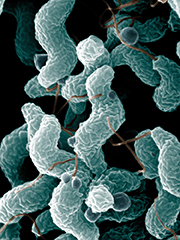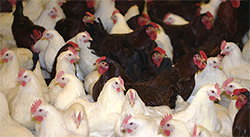TECHNOLOGY

Scanning Electron Microscope Image
of Campylobacter jejuni Bacteria
Foodborne Illness Due to Campylobacter - Primer
Campylobacter is a major cause of foodborne illness that can result in diarrhea, abdominal cramps, fever and vomiting for 3-6 days. The infection can also lead to irritable bowel syndrome, reactive arthritis, Guillain-Barré syndrome, and can even be deadly for some patients. The bacterium is commonly transmitted to humans from poultry, lives in the intestines of chickens, and after processing is a common contaminate found on about 65% of chickens sold by grocery stores.1 In the EU, Campylobacter causes more cases of foodborne illness than Salmonella, E. coli and Listeria combined with an estimated 280,000 cases in the UK and 9 million in the EU.2 The economic cost of treating Campylobacter in the UK is reported to be $1.5 billion, and over $5.6 billion in the US. In February 2016, the USDA announced new standards to reduce Campylobacter levels in poultry and turkey products in order to reduce illnesses caused by Campylobacter.
Prevention of Campylobacter Food Poisoning – Initial Focus

Fe3C feed additives are being developed
to prevent bacterial infection of poultry,
a common cause of food poisoning.
Akeso is focused on the development of a new generation of compounds, known as Fe3C, to treat bacterial infections and microbial biofilms that have broad-spectrum activity. The company’s lead Fe3C product is a feed additive that can prevent the binding of Campylobacter to the wall of the chicken’s GI tract. The Fe3C compound binds to a surface protein on the Campylobacter called MOMP, and prevents the MOMP protein from adhering to the epithelial cells lining the chicken’s GI tract. Importantly, Campylobacter will not become resistant to the Fe3C compound because it does not destroy the bacteria, but rather prevents binding and subsequent infection.
TOP OF PAGE
